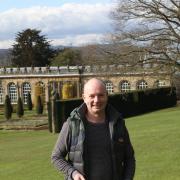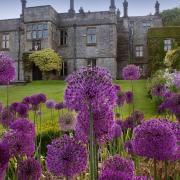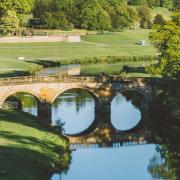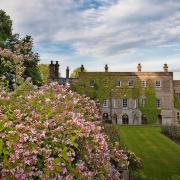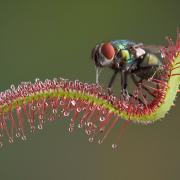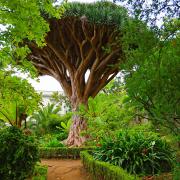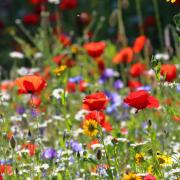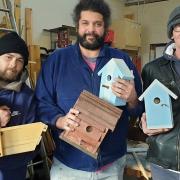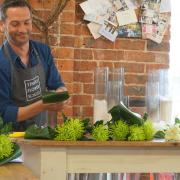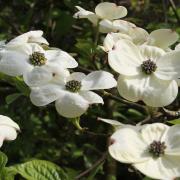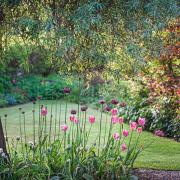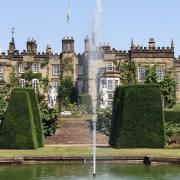Winners of a special award from the National Garden Scheme and an undisputed county treasure.
by William Morris as 'not in any sense our property, to do as we like with them. We are only trustees for those that come after us.' Cynthia and John Ramsden are not Fanshawes but they have made the Tudor-inspired garden of Fanshawe Gate Hall one of the most visited private gardens in Derbyshire.The work they have done and the welcome they offer is acknowledged to be so extraordinary that earlier this year they received the Exceptional Service award from the National Gardens Scheme (NGS). The couple, who have opened the garden for the past 15 years, are credited with epitomising the heart of the charity, 'bringing so much enjoyment to thousands of visitors over the years and raising money for such worthwhile causes.'It is the most tranquil garden imaginable, imbued with something of the glory of God and a place of recovery from the oesophageal cancer which struck Cynthia 11 years ago. Her beautifully illustrated coffee table book, A Garden in My Life, published in 2001 for Macmillan Cancer Support, does not dwell on that period of her life but in her own words is 'an account of one woman's pleasure in creating her garden.' Her continuing delight in it is evident in every blade of grass, every flower bed, every newly planted seedling.The couple are celebrating 50 years at Fanshawe Gate, which dates back to 1260. They met at Dronfield Grammar School, founded in 1579 under the will of Henry Fanshawe and now bearing his name, and when they married, built a house in Ecclesall. They had been there seven years, had started what became a family of five children, and had no intention of moving - until they saw the Hall advertised in the Saturday property section of the local paper and 'just had to have it.'The first 12 years saw the start of restoration on a house and cottage which were largely 16th century but where the remains of a mediaeval dwelling were still in evidence. The Ramsdens are only the fourth owners of what became a tenanted farm, sold by the Fanshawe family in 1944. The present head of the family, Simon Fanshawe, visits twice a year, and the school now possesses the beautifully illuminated family tree discovered by a Leeds solicitor and presented to it by John Ramsden, who was then its chairman of governors.Of both house and garden, John says, 'We took 40 years to do it - we were very much finding our feet and it would have been foolish to employ a professional architect or landscape architect and do it all at once, even if we'd been able to. We would certainly have regretted it.'Visitors begin their tour in the lower courtyard of the steeply terraced property, in front of the cottage that was used as a stable and storage building in Victorian times and which the Ramsdens extended to accommodate their growing family, Nicola, Louise, Mark, James and Anna. The courtyard itself evolved with different phases of family life and was gravelled over as parking space when the teenagers acquired cars. When they left home, Cynthia was able to plant the Elizabethan knot garden that so eloquently reflects the age of the present house.A herb garden by the cottage wall reflects it too, as does the tithe barn in view, surrounded by strutting chickens and dating from around 1536. The grassy banks that line the courtyard are steep, with relics of farming history in the shape of staddles, mushroom-shaped stones which were the foundation for corn ricks. 'Someone found us an old postcard from the turn of the century, and the whole of this area was haystacks,' Cynthia says. Snowdrops planted 20 years ago from a neighbour's garden proliferate here in spring and she marvels, 'There was just a circle round each tree. Look how they've spread.'The medieval dovecote commands attention, poised as it is between the first two levels of this five-level garden. It is unique in having three storeys, the uppermost still inhabited by a flock of birds. The original inch-thick glass remains in its tiny window and the Ramsdens have dug up other pieces of mediaeval glass on the site - including one particularly large fragment that was subsequently dropped by a small grandchild. No recriminations followed: grandchildren are cherished here and trees planted to commemorate each birth. When the Ramsdens arrived 50 years ago, the whole of this second level of the garden was populated by laurels, which Derbyshire farmers used to plant for pecking hens to scratch beneath. Cynthia outed these in favour of rhododendrons, which proved 'fine in spring but uninteresting for the rest of the year.' So John terraced the bank to allow shrubs to be planted and a flow of colour to continue down each terrace. Shade-loving plants occupy a border in front of a woodland area of old lime trees, where an unusual summerhouse draws the eye.The shape and timbers make it look quite un-English in many ways. It had a thatched roof in Cynthia's grandfather's day, when it stood in his garden for tea parties and for the children to play house in. Cynthia's passion for gardening comes from her grandfather, so she was thrilled when the spinster aunt who remained in the house after his death suggested she might like to have it.It was just the start of the unravelling of a piece of history that became more intriguing with each revelation. Grandfather had bought the summerhouse at an agricultural show in 1934 and the family had always assumed it to be new. But when Cynthia and John's son, Mark, spotted a replica summerhous at the Chelsea Flower Show and had a conversation about it, the discovery was made that the Ramsdens' summerhouse was in fact made at the turn of the century by Julius Caesar & Sons of Knutsford. The buildings were produced for King Edward VII, who presented them as a thank-you present to hostesses who had pleased him at weekend house parties. 'Can you imagine the gentry going round each others' houses to see who had got one?' Cynthia speculates in delight.Planted bronze in solid blocks at intervals breaks up the variegated border by the wall. The flourishing magnolia tree in this part of the garden is 25 years old, and space has run out for the commemorative Old English fruit trees for the grandchildren - mulberry, walnut and medlar for the first three girls and fig trees for the first two boys. The last four grandchildren have trees in the orchard instead. You can peer down through a grille to marvel at the deep shaft of the original well, the only water supply when the family came here 50 years ago. It was piped to the house and 'made a wonderful cup of tea,' Cynthia remembers. The Fanshawe coat of arms has been put on a set of imposing gates, with the family's permission and to their great pleasure. They open on to a delightful gravel walk, which Cynthia admits has been 'all kinds of things. It was full of those big show dahlias when we bought it.'I didn't like them - they irked me, they didn't go with the property at all. I put in any old roses and then I decided on a colour scheme,' she says. 'This is blue and gold: golden standards, blue clematis between the climbing roses ... And alchemilla mollis - gorgeous, but gets everywhere - blue catmint in the front and agapanthus in between ...' Her gentle enthusiasm is unbounded. The topiary in this part of the garden is very much in keeping with the age of the property. Mark Ramsden made the water feature that cascades down a high wall in summer, to celebrate the marriage 16 years ago of his youngest sister, Anna. 'We are a great family for commemorating things, and this is all his own work. It has weathered beautifully and is very pretty in action,' Cynthia observes. Clumps of poppies have self-seeded among a border of ferns and hostas by the house, and have been retained for their splash of colour.The borders in front of the house are historic, containing plants known to have been grown in this country in the 1600s. Convolvulus had invaded one and the whole border was to be removed, 'starting at 8am on Monday morning.' To mark their 50 years, John and Cynthia will create a new border here, by a fountain known affectionately as 'Cynth's pissing nymph'.What was once a sloping field is now a beautiful formal orchard, planted with Old English varieties of apples, pears, plums and damsons and neatly edged with box and lavender. A hornbeam hedge, a very Tudor concept, was put in two years ago, and a natural dip in the land lent itself to a pond, fed from a well across the nearby field. The overflow is piped out of the pond and under the drive into the original well in the garden. 'When this is mature, in summer, it's lovely. That bank in particular encourages moisture-loving plants,' Cynthia says. 'We get frogs in here, and the grandchildren insist on putting up signs saying, "Please do not tread on the baby frogs".' Another 50-year commemoration will be an oak pergola into John's vegetable garden, around which roses and vines will grow. His garden has raised beds - 'He insisted on them,' Cynthia says with a smile - and the pice de r�sistance of his domain is the garden shed which the family call his Chapel of Rest. It is insulated with pine from a cricket pavilion; it has pale green gingham curtains (despite his protests), and it houses his gardening books, kettle, coffee maker, radio and heater. A piece of stained glass incorporated into the window has come from a window which was the couple's wedding present to each other, designed by their art teacher at school for their Ecclesall house. The present owners were doing alterations and asked them if they would like the glass, which has the school's Fanshawe crest in it. They loved the idea but couldn't think where to put it until Mark had the top of the shed window taken out and the stained glass border put in as a surprise. From the vantage point of the vegetable garden, Dore and Totley come into surprise view in the valley below, ringed with hills. It's a reminder how near the house is to Sheffield and yet how remote it seems when you look across the rural landscape in all other directions. The family had years of ferrying the children to school from here, the girls to Sheffield High School and the boys to Lady Manners School, Bakewell, but they wouldn't have had it any differently.And if there's one thing that perfectly sums up their joy in the garden and the artistry that Cynthia has put into creating it, it is the glass tear drops suspended from a fountain-shaped piece of topiary by the house. They came from a broken chandelier the couple were given, augmented by a wooden box of chandelier pieces they picked up by chance in a curiosity shop in Suffolk.'They're supposed to be like big drops of water, but I couldn't get the fronds to come down,' Cynthia says, viewing it critically. 'I tried lead weights and everything, but it needs re-wiring.' She touches one of the droplets and reflects, 'When the sun shines through, it looks like drops of water forming. In winter, when snow is on the topiary, it looks like icicles.' She will have another fundraising book out this autumn, a soft-back with a Canterbury Tales approach from those who love the garden as much as she does. It should be an inspiration.



